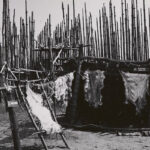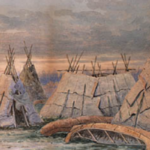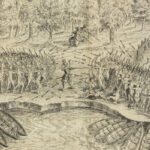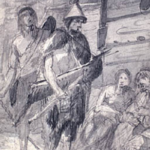The Indigenous Nations and First Nations Bands of Quebec: A Historical Overview
Quebec is home to a diverse array of Indigenous Nations and First Nations bands, with 55 recognized bands representing groups such as the Cree, Innu, Mi’kmaq, Mohawk (Kanien’kehá:ka), Atikamekw, Algonquin (Anishinaabe), Huron-Wendat, Naskapi, and Inuit. Each of these nations carries a unique cultural heritage deeply rooted in the land’s rivers, forests, and coastal areas. Their pre-European lifestyles, political systems, warfare practices, spiritual beliefs, and food systems reflect a deep connection to the environment and a remarkable resilience in adapting to centuries of change.
Pre-European Contact Lifestyle
Before European contact, the Indigenous peoples of Quebec developed lifestyles finely tuned to the province’s varied ecosystems. In the boreal forests of northern Quebec, the Cree, Naskapi, and Innu lived as semi-nomadic hunters and fishers, following seasonal migration patterns to sustain their communities. Caribou, moose, beaver, and fish were dietary staples, supplemented by berries, roots, and wild plants. The Mi’kmaq and Mohawk, located in the St. Lawrence Valley and along the Gulf of St. Lawrence, were both fishers and horticulturalists, cultivating crops such as corn, beans, and squash (the “Three Sisters”) (Trigger, 1990).
Housing and transportation reflected their adaptability. Longhouses, particularly among the Mohawk and Huron-Wendat, provided communal living spaces, while wigwams and portable shelters suited the mobility of the northern Cree and Innu. Birchbark canoes facilitated travel across the rivers and lakes that interconnected their territories.
Social Structures and Slavery
Social organization varied among Quebec’s Indigenous peoples. Among the Mohawk, society was matrilineal, with clan mothers holding significant authority in decision-making and the appointment of chiefs. The Huron-Wendat and Mi’kmaq also employed complex clan systems to manage resources and relationships. In contrast, the Cree and Innu followed a more egalitarian structure, where elders provided guidance and leaders emerged through merit and consensus.
Slavery, while not widespread, existed in some communities, often as a result of intertribal warfare. Captives were sometimes enslaved but were frequently assimilated into the community, reflecting a flexible and integrative approach to identity and social cohesion. Historian Bruce Trigger notes, “The incorporation of captives into Indigenous societies often blurred the lines between slavery and adoption, emphasizing communal survival over rigid hierarchies” (Trigger, 1990).
Politics and Governance
Political systems among Quebec’s Indigenous nations were decentralized, with governance tailored to the specific needs of each community. The Mohawk were part of the Haudenosaunee (Iroquois) Confederacy, an advanced political alliance governed by the Great Law of Peace, emphasizing consensus and diplomacy. This confederacy served as an early model of collective governance and influenced European settlers’ understanding of democracy.
The Cree and Innu relied on councils of elders and skilled leaders who acted as mediators and decision-makers. Among the Huron-Wendat, village councils and alliances with neighbouring groups ensured cohesion and mutual protection. Political relationships were often reinforced through trade and ceremonial gatherings.
Warfare and Alliances
Warfare was both a practical and ritualized aspect of life, particularly for the Haudenosaunee. Conflicts often revolved around resource competition, territorial disputes, and vengeance. The Mohawk, as the easternmost members of the Haudenosaunee Confederacy, were known for their strategic military prowess and their involvement in the Beaver Wars against the Huron-Wendat and other nations.
Warfare among the northern Cree and Innu was less formalized but no less significant, often involving skirmishes over hunting territories. Alliances, such as those between the Mi’kmaq and the French during early colonial conflicts, highlight the strategic diplomacy that Indigenous nations employed in dealing with both Indigenous and European adversaries (Havard, 2001).
Spirituality and Origin Stories
Spiritual beliefs were central to every aspect of life. The Cree and Innu viewed the natural world as alive with spirits, each entity possessing its own power and significance. Shamans played key roles in mediating between the spiritual and physical realms, conducting ceremonies to ensure balance and prosperity.
Origin stories provided moral frameworks and cultural identity. Among the Mohawk, the Sky Woman narrative explained the creation of the Earth and underscored themes of harmony and interconnectedness. The Mi’kmaq told of Glooscap, a cultural hero who shaped the land and taught humanity how to live in balance with nature. These stories, passed down orally, served as living histories, binding communities through shared understanding (Trigger, 1990).
Food Systems and Trade
Quebec’s Indigenous peoples demonstrated remarkable ingenuity in their food systems. The Mohawk and Huron-Wendat cultivated extensive fields of corn, beans, and squash, using intercropping techniques to maximize soil fertility. The Cree and Innu relied on hunting and fishing, with caribou hunts and salmon runs forming the backbone of their subsistence.
Trade networks were extensive, connecting the Indigenous peoples of Quebec with those as far as the Great Lakes, Atlantic coast, and Hudson Bay. Copper, furs, and shells were among the goods exchanged, fostering not only economic but also cultural relationships. Historian Peter Havard described these networks as “the arteries of pre-contact North America, carrying goods, ideas, and alliances across vast distances” (Havard, 2001).
Contact with Europeans
The arrival of Europeans in the 16th and 17th centuries introduced profound changes. French explorers, led by Jacques Cartier and Samuel de Champlain, established trading relationships with the Mi’kmaq, Innu, and Huron-Wendat. These alliances were critical to the fur trade, which became a cornerstone of both Indigenous and colonial economies.
However, contact also brought devastating consequences, including smallpox and measles, which decimated Indigenous populations. Missionaries introduced Christianity, often clashing with traditional beliefs, though many Indigenous peoples adapted these teachings into syncretic spiritual practices. The imposition of European treaties and colonial policies further disrupted traditional governance and land use.
Legacy and Modern Resurgence
Today, Quebec’s Indigenous nations are vibrant and resilient communities working to reclaim their cultures, languages, and lands. The Cree, through agreements such as the James Bay and Northern Quebec Agreement, have asserted their rights and established self-governance. The Mohawk, particularly in Kahnawà:ke and Kanesatake, have been leaders in land rights advocacy and cultural preservation.
Efforts to revitalize languages, restore traditional ecological knowledge, and celebrate heritage through powwows and festivals demonstrate the enduring strength of Quebec’s Indigenous peoples. Organizations like the Assembly of First Nations Quebec-Labrador play pivotal roles in promoting self-determination and reconciliation.
Conclusion
The Indigenous Nations and First Nations bands of Quebec exemplify the depth and diversity of Canada’s Indigenous heritage. Their sophisticated pre-European societies, adaptability to change, and ongoing cultural resurgence are testaments to their enduring spirit. As historian Bruce Trigger stated, “The history of Quebec’s Indigenous peoples is not a relic of the past but a living testament to resilience and renewal” (Trigger, 1990). Their stories continue to shape the province, offering lessons in stewardship, community, and perseverance.
References
- Trigger, B.G. (1990). The Huron: Farmers of the North. Holt, Rinehart, and Winston.
- Havard, P. (2001). The Great Peace of Montreal of 1701: Diplomacy in New France. McGill-Queen’s University Press.
- Miller, J.R. (2001). Skyscrapers Hide the Heavens: A History of Native-Newcomer Relations in Canada. University of Toronto Press.



